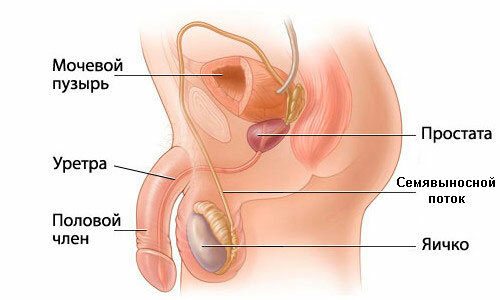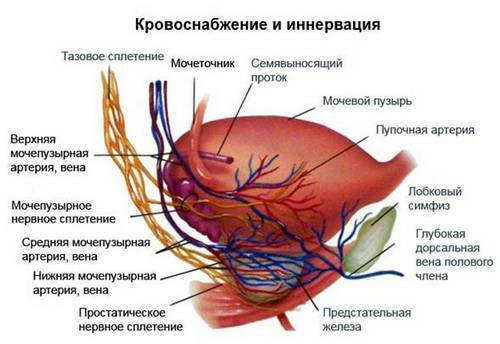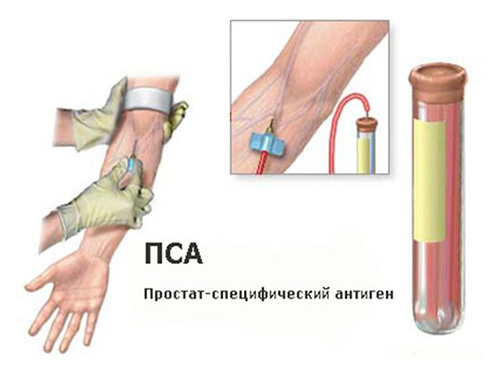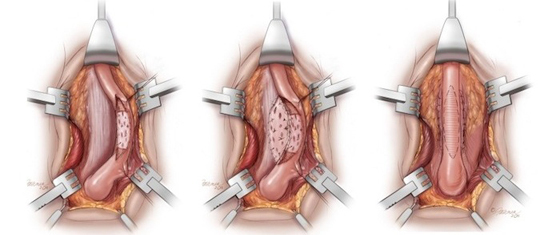Structure and function of the prostate gland in men
Prostate, or prostate gland is an unpaired organ of the genitourinary system, the "second heart" of a man. Adequate work of the prostate gland is the guarantee of a stable psychoemotional state of men. Harmonious functioning of the prostate largely affects the overall health and determines the ability to conceive a child throughout life.

Location of the prostate
Contents
- 1 Structure
- 1 Blood supply and innervation
- 3 Functions
- 3.1 Secretory function
- 3.2 Barrier function
- 3.3 Motor function
Structure
The prostate is located in the central part of the male pelvis, directly under the bladder. The upper( apical) part of the prostate gland is in contact with the urogenital diaphragm, from behind comes to the anterior wall of the rectum. This localization of the prostate gland allows you to palpate it through the anus.
The prostate gland is a glandular-muscular organ that resembles a chestnut in shape. The lower part of the prostate covers the initial section of the urethra( urethra).Through the prostate gland, the male seed enters the urethra, from where it comes out during ejaculation( ejaculation).
The posterior part of the prostate is anatomically connected with the vas deferens and seminal vesicles. The vas deferens enter the surface of the prostate gland, descend downward and downward in its thickness and come out in the region of the posterior part of the urethra - at the tip of the seminal tubercle. On the surface of the seminal tubercle, also open the own ducts of the prostate, bearing a specific secret.
Before the puberty period, the prostate gland consists mainly of muscle tissue. At the age of 14-18 the prostate begins to grow actively. The mass of the prostate gland in adolescents increases mainly due to the appearance of glandular tissue. After puberty, the prostate is able to secrete a secret and function as a complete gland. In old age, the secretory function of the prostate is lost, and the prostate gland decreases significantly in size.
Blood supply and innervation

Blood supply and innervation of the prostate
The main source of blood supply to the prostate is the lower artery of the bladder. This vessel is a branch of the large iliac artery. A few fine branches( from two to five), the arteries of the prostate gland, leave the bladder artery. Branched into the thickness of the prostate, the arteries provide the body with oxygen and nutrients necessary for its full functioning. Blood supply of the prostate gland is also realized due to the branches of the hemorrhoidal arteries and perineal vessels.
Venous outflow of blood from the prostate is carried out by a network of small veins, flowing into the plexus around the bladder. From the prosthetic venous plexus, the blood enters the vesicles and further into the lower vena cava. Through the veins from the prostate, the exchange products are removed and, thus, adequate work of the organ is provided.
The outflow of lymph from the prostate gland passes through the lymph nodes and vessels around the organ. Further lymph flow is carried out along the iliac arteries, near the sacrum and rectum. Pelvic lymph nodes are the first to respond to pathological changes in the prostate and increase in size. Inguinal and perineal lymph nodes are also susceptible to various inflammatory processes in the prostate gland.
The innervation of the prostate is carried out by the branches of the hypogastric plexus. Individual nerve fibers form their own network around the prostate and nearby organs. In the thick of the prostate is also a lot of receptors that react to the most diverse changes in the body.
Functions
The prostate gland performs three main functions:
- secretory;
- barrier;
- motor.
Secretory function of
The main role of the prostate is the development of a specific secret that ensures the sexual function of a man. The secret of the prostate is a whitish liquid with a specific odor. A day is formed 2 ml of secret, which is up to 30% of the total volume of sperm. Regulation of the secretory function of the prostate gland is carried out by hormones androgens. With a decrease in the concentration of androgens in the blood, the activity of the prostate is significantly reduced.
Read on: The effect of androgens on the prostate
The prostatic secretion consists of the following components:
- spermatozoon;
- phospholipids( lipoid bodies);
- enzymes;
- organic acids.
All substances that make up the secretion of the prostate serve one purpose - activation of spermatozoa. The secretion of the prostate gland makes the ejaculate liquid and fit for the existence of male sex cells. In the fluid produced by the prostate, also there is an exchange of testosterone and other sex hormones necessary for the full functioning of the body.
The prostate secretion study is widely used in the laboratory diagnosis of the pathology of the genitourinary sphere. The secretion analysis allows to detect prostatitis and some other inflammatory diseases in time, identify the causative agent of the disease and prescribe the treatment taking into account the available data.
Many urologists adhere to the theory that the prostate gland is one of the organs of the endocrine system of the body. This version has not received scientific confirmation. Until now, scientists have not been able to identify specific hormones produced by the prostate and fully assess its ability to function as an endocrine gland.
Barrier function
The prostate gland is the main barrier to the penetration of pathogenic microorganisms from the lower parts of the urethra into the bladder and kidneys. The secretion of the prostate contains lysozyme and other substances that have a harmful effect on pathogens. Protective function of the prostate is performed only with its full functioning.
Motor function
The prostate gland acts as a kind of valve. With the help of the muscular ring( sphincter), the prostate blocks the urine flow from the bladder to the urethra during ejaculation. Retention of urine is also carried out by the timely release of secretion into the lumen of the urethra. This ability of the prostate allows you not to mix urine and semen during sexual intercourse and in other situations, accompanied by ejaculation.
The prostate gland is an important organ that ensures the full existence of a man. To prevent the development of prostate pathology, it is recommended that all men of reproductive age undergo annual urological examinations.
Read: First symptoms of prostatitis and exacerbation
Recommended for viewing:



